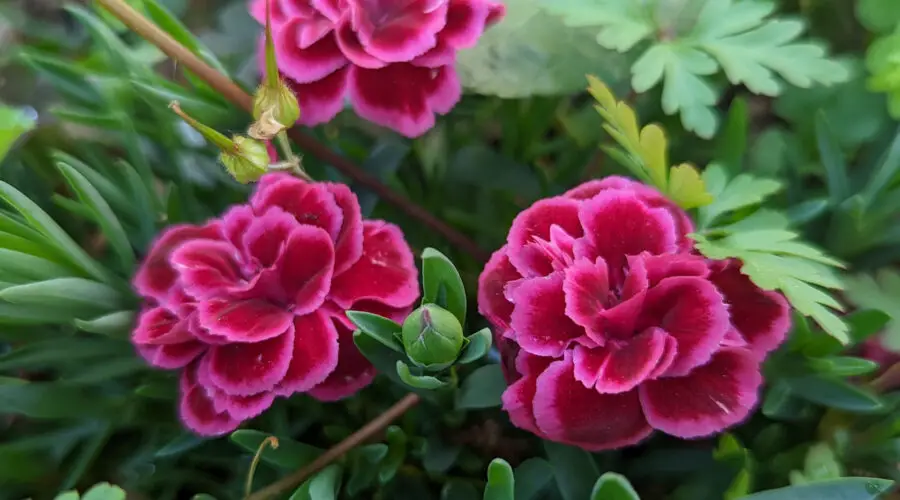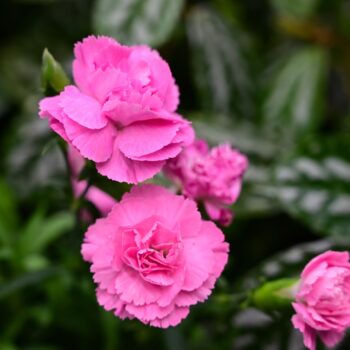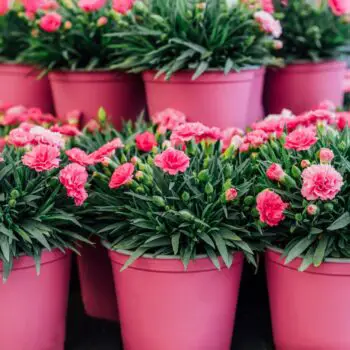How to Plant, Grow and Care for Carnations
Carnations are an iconic cut flower, either standing alone in floral arrangements or playing backup, accenting the leading players like roses or daisies. While many people love them in bouquets, they are unaware carnations can be grown at home in containers or in the garden.
The Basics of Carnations and Their Common Characteristics
Carnations (Dianthus caryophyllus) are bright pink, white, coral, or red flowers with long sturdy stems, prominent nodes, and a double layer of silky petals. The stiff stems have narrow, pointed oval-shaped leaves in a bluish-green shade.
Plants are related to the commonly grown dianthus, also known as Sweet William (Dianthus barbatus). Both are members of the Dianthus genus. Carnations grow as perennial plants, with most cultivars reaching two feet tall (60 cm). Sweet Williams grow shorter to the ground and have a biennial life cycle.
Dozens of varieties are available for growing in a home garden. Large-flowered, standard carnations, spray carnations, and dwarf flowered carnations are the type usually grown commercially for arrangements. Spray carnations and the dwarf-flowered types are most commonly grown in home gardens.
Different Ways to Grow Carnations
Carnations grow well in containers—indoors or outside—or when planted directly into the garden. Deciding where to grow plants is dependent upon your climate. In warmer, milder areas, plants may stay green all year. But in colder climates, they go dormant for the winter, regrowing in the spring.
For most types to survive the winter, you must live in a USDA growing zone 6 or warmer.
Growing Carnations in the Garden
- To grow carnations outdoors, they need a location that gets at least four to six hours of sunlight every day. Planting them in a shady spot will result in fewer blooms and lackluster growth.
- They prefer a slightly alkaline soil pH just above neutral.
- Pick a garden bed that is deep enough to accommodate their dense, fibrous root system.
Growing Carnations in Pots
When growing carnations in containers, whether indoors or outside:
- Choose a container deep enough for the root system with drainage holes in the bottom.
- Choose a well-draining substrate such as potting soil or coconut coir.
- Avoid overcrowding in the pot, spacing plants at least 6 to 12 inches apart.
How to Start Carnations
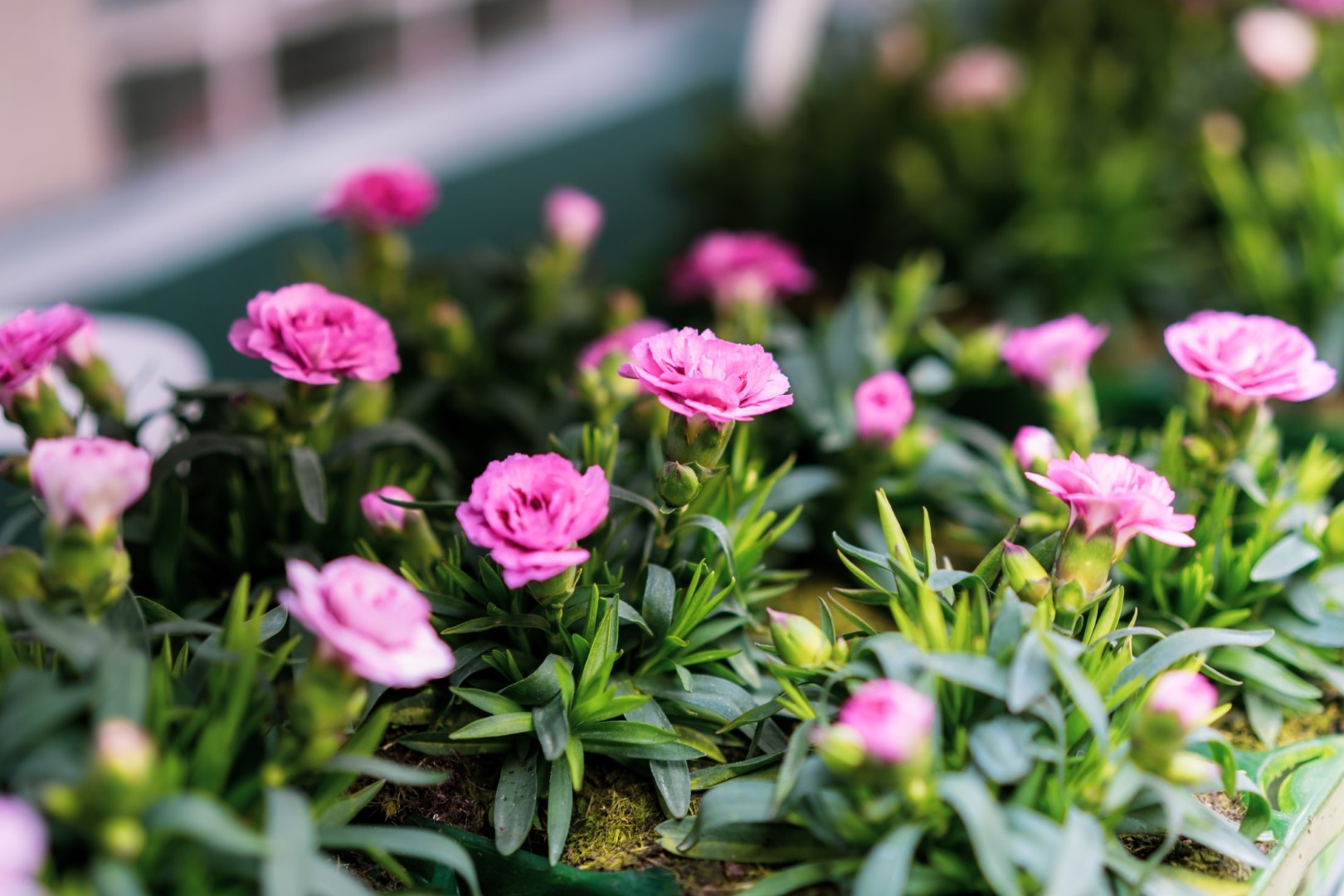
If you’re interested in growing your own carnations, you can either propagate plants from cuttings or start plants from seed.
- Propagating cuttings gives quicker results and guarantees you’ll have an identical clone of the parent plant.
- Sowing seeds reduces the chances of passing insect problems or diseases to the new plant(s). But sowing seeds results in tender seedlings that are more delicate.
How to Grow Carnations from Cuttings
Carnations are easy to propagate and an inexpensive way to replace old plants or add to your collection. Summer is the ideal time to propagate since plant cells are dividing quickly, resulting in faster root development and growth. You want to always work with strong shoots with at least five pairs of leaves and no flowers.
- Remove 4 to 6” stem pieces from the tops of healthy shoots using disinfected, sharp scissors or shears.
- Pinch all the leaves off of the bottom half of the stem.
- Fill a container with pre moistened potting soil or coconut coir.
- Push the stem cuttings about half an inch into the growing medium, making sure to space individual cuttings so none of the leaves touch one another.
- Thoroughly water the growing media.
- Cover the top of the container with a plastic bag.
- Set the pot somewhere where it gets plenty of bright, indirect sunlight.
- When the cuttings have successfully rooted, pot each one individually or transplant them to the garden.
How to Grow Carnations from Seeds
If you choose to plant carnations from seed, select cultivars suitable for your winter temperatures. You can either direct sow them into the garden after the threat of spring frost has passed or start seeds indoors in containers six to eight weeks before. Seeds sown directly in the garden may not bloom their first year.
It isn’t necessary to pre-soak seeds before planting, but you can soak them in water overnight if you want to improve germination rates. The seeds should germinate within five to seven days but can take fourteen to twenty-one in cooler conditions.
- Sprinkle seeds over the soil surface or top of the potting soil.
- Cover them lightly with one-eighth to one-quarter of an inch of soil.
- Cover the containers with a plastic bag to create a miniature greenhouse if starting seeds indoors.
- Keep the soil moist without overwatering.
How to Transplant Carnations Into the Garden
Once your seedlings are four or five inches tall, they’re ready to be transplanted outside if the danger of frost has eased. The goal is to transplant seedlings into the garden during the spring when it’s not too cold or hot.
Before transplanting, the seedlings need to be “hardened off” for about a week by setting them outside in a sheltered location every day. Acclimating them to outdoor conditions in this way helps to minimize transplant shock.
Once your seedlings are hardened off, work two to four inches of finished compost into the top twelve inches of garden soil. Space plants about twelve inches apart and ensure the top of the root ball is level with the soil surface. Tamp the soil down firmly as you backfill around the plant.
Carnations Growing Season and Bloom Period
When grown outdoors, carnations begin to flower in late spring, typically in May, but this depends upon the specific climate. Once they start flowering, blooms last about eight weeks, extending the growing season deep into summer, similar to roses and hydrangeas. Deadheading the spent blossoms stimulates new bud growth and may extend a plant’s bloom time.
Plants begin preparing for winter dormancy as the temperature drop and day lengths shorten in the fall. They die back to the ground entirely after the first fall frost, but since carnations are perennials, their root systems stay alive underground. New shoots will appear from the roots once temperatures start climbing again in the spring.
Caring for Your Carnations
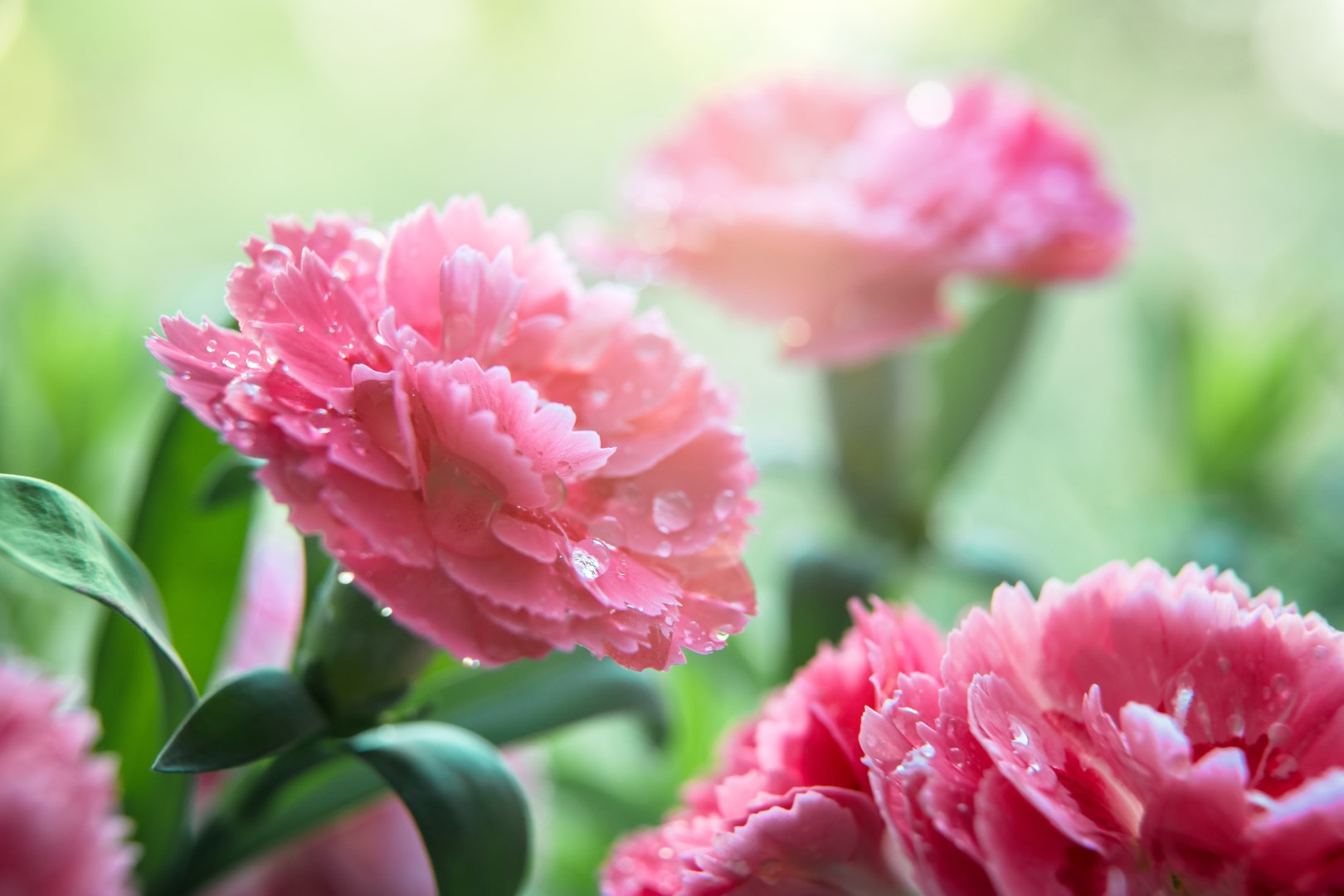
Carnations aren’t difficult to grow if you give them the correct amount of sunlight and water and feed them with fertilizer periodically.
Correctly Watering Your Plants
After planting carnation seeds, you must water them well for the first few weeks to help them establish their root systems. Keep the soil moist without having it be saturated or soggy.
After the first few weeks, switch to watering them when the top of the soil is dry. Plants are pretty drought tolerant, but they need regular water in the spring for bud formation. They may also need a little extra water during hot, dry spells during the summer.
To encourage deeper root growth and improve drought tolerance, water the soil thoroughly once or twice a week instead of watering your carnation plants a little every day.
Be careful not to give them too much water. Overwatering results in yellowed leaves and droopy or dropping petals.
Fertilizer Needs and Frequency
Carnations need regular fertilization to replenish the nutrients they pull from the soil. Throughout the active growing and blooming season, give them a dose of fertilizer every four to eight weeks. Stop fertilizing once the flowering ceases in the fall.
Instead of using a balanced fertilizer, or a standard garden fertilizer for vegetables, use a flower-specific formulation with lower amounts of nitrogen than phosphorus. A good ratio is 5-10-10 or 5-10-5. This ratio encourages bud development over prolific vegetative growth.
Deadheading Plants For Longer Bloom Periods
Deadheading is the process of removing spent flowers from a plant after it has bloomed. Removing the dead blossoms encourages new bud development on the plant as well as new plant growth. Thus, prolonging the bloom time.
After flowers have faded, use your fingernails to pinch them off the plant or cut them off with clean, sterilized gardening shears.
How to Keep Pests Away
Both indoor and outdoor carnations are prone to insect pests, although outdoor plants are susceptible to a broader range of species.
- Aphids and spider mites are common pest problems in indoor plants.
- Garden-grown plants also have trouble with aphids and spider mites, but they are also prone to infestations of leafminers, gall mites, cabbage loopers, Cyclamen mites, nematodes, and brown soft scale.
Insect pests often need to be treated more than once. Start by trying to physically remove pests if possible. Then treat with an insecticidal soap or neem oil, covering the entire plant. You should move container-grown plants away from other, healthy plants to prevent the spread of pests.
Common Carnation Diseases
Carnations often suffer from root rot, bacterial leaf spots, and Fusarium wilt. Regularly inspect your plants for signs of disease, especially in cool, wet weather. If you observe infected plants, removing them from the garden may be best instead of trying to treat the problem.
If you attempt treatment, ensure you correctly diagnose the disease and choose a fungicide or bactericide labeled for use on the specific issue. Follow all label directions regarding dosing, frequency, and safety precautions.

